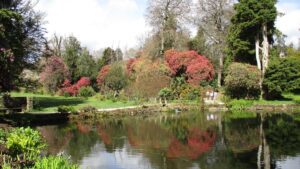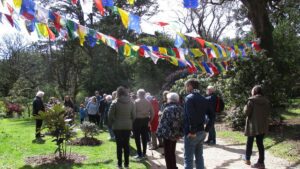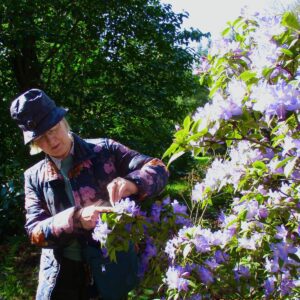On April 15th a large group of lucky members from Co. Down and Waterford visited Kilmacurragh where magnificent rhododendrons were in full flower.
Philip Quested, our guide, a self professed Tree Man, shared his depth of knowledge about the remarkable trees in Kilmacurragh. No sooner had we passed through the entry gates, he was pointing out the Wollemi pine, which is now a substantial tree looking very healthy and strong. Philip was justifiably proud of this specimen which is included in the Conservation Project for this very rare ‘pine’, Wollemia nobilis, which is actually related to Araucaria and not a pine at all. He pointed out that this tree is growing much better in Kilmacurragh than in New South Wales, where the few remaining examples of the species were ‘discovered’ in 1994. Previously it was known only from fossils, and it is on the Red List of Endangered Species. Philip underlined the importance of Kilmacurragh as a world conservation site for many of its other rare trees as well.
Then it was onto the meadow where, where the delightful ‘hoop petticoat’ daffodils (Narcissus bulbicodium), snakeshead fritillaries (Fritillaria meleagris) and other meadow beauties were flourishing among the grass, and one member asked Philip how this delicate effect could be achieved. This gave him the opening to remind us that a wild-flower meadow is no easy option, and that many of the ‘wildflower seeds’ on sale are imported and may contain the invasive ‘black grass’ seed, Alopecurus myosuroides. The beautiful meadow we were looking at, of fine grasses and jewel-like small flowers, had been carefully tended and given assistance to rid it of coarse grasses by using yellow rattle (Rhinanthus minor), which parasitises the grass, reducing its vigour and allowing the finer plants to dominate. This meadow, though not a true ‘wildflower’ meadow, is called a ‘pictorial meadow’ and it was indeed a lovely picture.

But of course, the stars of the visit were really the magnificent old rhododendrons, planted by the Actons in the nineteenth and early part of the twentieth centuries.


Rhododendron augustinii.
If you missed Rhododendron Week at Kilmacurragh this year, make sure to put it in your diary for 2024. (Courtesy of Mary Montuat).
